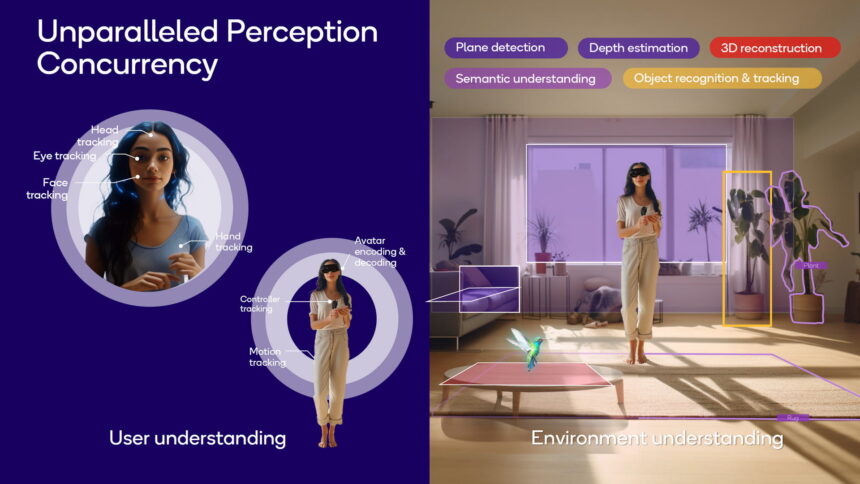"Spatial Computing is a Qualcomm-sized Challenge"

Qualcomm is presenting itself as an XR innovator and wants to solve the challenges for “perception technologies” like AR.
Qualcomm's new office in Vienna is as unspectacular as one can imagine. It could be the office of a medium-sized sales company, if it weren't for the letters on the door. There are a few desks with PCs in the open-plan office, separated in the center by long white chests of drawers holding equally long planters of matching greenery.
Meeting rooms and a kitchen are as normal as in any other office – there is nothing extravagant about the Austrian branch of the world's fifth-largest semiconductor manufacturer (2021). This fits in with the emphatically shirt-sleeved attitude of the Qualcomm representatives, including their Vice President for XR, Hugo Swart, who joined us live.
“We want Apple to succeed”
At a press event in Vienna on 20 September, Qualcomm is positioning itself as the company best suited to meet the challenges in the XR space, particularly in developing AR headsets for everyday use.
Indeed, Qualcomm believes the era of 5G, AI and XR is dawning, according to Jerome Jacqmin, senior director of marketing in Europe. “We've been using the term 'spatial computing' for three years now,” he says, taking a swipe at Apple, which tried to use the term to differentiate itself from the more common mixed reality term when it unveiled its Vision Pro VR/AR headset.
The market needs to grow, he says, and that can only happen with broad industry participation. “We want Apple to be successful,” says Jacqmin with a wink. “But not too successful.”
XR2 Gen2 and AR1 Gen 1 as first dedicated steps into XR era
Qualcomm's involvement in the XR space began back in 2007, when the company launched its first AR project. A lot has happened since then, most notably with the launch of the first standalone VR headset, such as the Oculus Quest in May 2019. The headset used a Qualcomm Snapdragon 835, and just two years later Qualcomm followed up with the much more powerful Snapdragon XR 2 in Meta's Quest 2.
Now the company is looking to make a similar leap with the announcement of a new generation, the Snapdragon XR2 Gen2. The chip powers Meta's just-released Quest 3 VR/AR headset, and the performance data is impressive: Compared to the XR2, the XR2 Gen2 offers 2.5 times the peak performance and 50 percent better power efficiency.

Qualcomm's “perception technologies” are based on the cornerstones of user understanding and understanding the environment, the company says. | Image: Qualcomm
The chipset supports displays up to 3k × 3k resolution and performance technologies such as Foveated Rendering, Space Warp and Game Super Resolution. The Snapdragon XR2 Gen 2 can also process data from up to ten cameras and enables passthrough with a latency of up to 12ms. It also supports the new Wi-Fi 7 standard for wireless data transfer, as well as 6E and Bluetooth 5.2 and 5.3.
Why isn't the new chip called the XR3? “Because it is still an XR2,” Jacqmin replies laconically. “Just significantly improved. Maybe we'll see an XR3 chip at some point, but until then, we think the XR2 label is a good fit for this type of chip.”
The XR industry is leaning heavily towards augmented reality. But making AR headsets suitable for everyday use is still a tough challenge, that even Apple hasn't been able to solve, despite clearly having its sights set on it. That's why XR hardware manufacturers are currently focusing on the best alternative: the see-through or pass-through capabilities of VR headsets like the Quest 3 or Vision Pro. This is about merging the digital world with the real world, which is essential for a meaningful metaverse concept.
“Miniaturization is on the way”
As an XR innovator, Qualcomm feels it has a responsibility to make the future of AR possible and to cram the necessary technology into relatively ordinary spectacle frames. “We're getting there. The miniaturization is definitely on the way,” says Qualcomm's Jerome Jacqmin. The first dedicated step in this direction is the new Snapdragon AR1 Gen1 chip for upcoming smart and AR headsets.
The chip supports 3DOF, a resolution of 1,280 × 1,2080 pixels per eye, 12-megapixel photos and 6-megapixel videos. The integrated AI solution enables visual search, targeted audio capture and real-time translation. According to Qualcomm, data transfers of up to 5.8 gigabytes per second are possible via Wi-Fi 7.

Areas of application for Qualcomm's AR1 Gen1 chip. | Image: Qualcomm
The chip is being used for the first time in Ray Ban | Meta smart glasses, which Meta unveiled at Connect 2023 on Wednesday and are an impressive piece of technology in this form factor.
Qualcomm has acquired several startups in the last few years to strengthen its position in areas such as computer vision and location-based AR. The company also offers Snapdragon Spaces, an open development environment with features such as spatial, hand and finger tracking, image and object recognition, 3D mapping of the environment, permanent anchoring of objects in the environment and realistic occlusion of digital objects.
Spaces is growing, with more than 5,000 developers reported to have joined the platform in the last 12 months alone. Additional partnerships with Unity and Epic Games are expected to create further synergies in solving the challenges of the XR era.
Immersive technologies have the potential to be disruptive
Qualcomm is not the only company to believe that immersive technologies are here to stay. The possibilities of VR and AR, which have only been explored to a very limited extent, give a pretty good indication of where the disruptive changes are likely to come. Anything that makes information or interaction available to people faster, easier and more intuitive, or that enables more efficient forms of communication, has the potential to become mainstream.
But this potential has to be put into practice. That could take some time.
The biggest obstacle for VR currently is the lack of content and experimental software that breaks the usual monotony of bland first-person shooters and explores the spectrum of the technology beyond VR games.
With AR headsets, on the other hand, the obstacle is physics. I'm curious to see how quickly developments in this area will progress and, above all, what the first real AR headsets suitable for everyday use with dedicated displays will be able to do. Meta plans to introduce the first such headset for demo purposes next year, but a consumer version is not planned until 2027.
That could be enough time for Qualcomm to become the market leader with something like an XR3 or AR3.
Note: Links to online stores in articles can be so-called affiliate links. If you buy through this link, MIXED receives a commission from the provider. For you the price does not change.